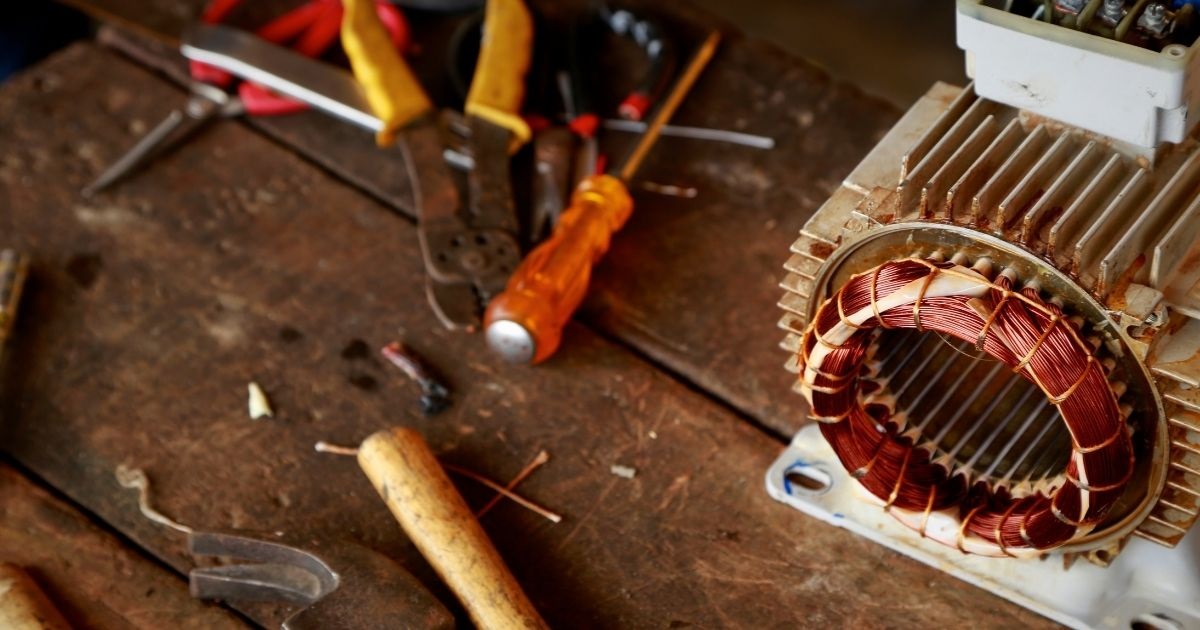Electric motors are the workhorses behind many industrial processes, powering everything from conveyor belts to pumps and fans. While these motors are designed for durability and long-term performance, unexpected breakdowns can and do occur, often at the most inconvenient times. When a motor fails, it can lead to significant downtime, disrupted operations, and costly repairs. To minimize the impact of these unforeseen events, it’s crucial to have a plan in place for handling motor failures. In this blog, we’ll explore how to prepare for unexpected electric motor breakdowns and the importance of having access to emergency motor services.
Understanding the Causes of Motor Breakdowns
Before diving into the preparation strategies, it’s essential to understand some common causes of electric motor breakdowns. By recognizing these factors, you can take proactive measures to reduce the risk of failure.
Common Causes of Motor Failure
Several factors can contribute to the unexpected breakdown of an electric motor. These include:
- Overheating: Excessive heat is one of the leading causes of motor failure. Overheating can result from overloading, poor ventilation, or operating in high-temperature environments.
- Electrical Issues: Problems such as voltage imbalances, insulation breakdown, and short circuits can lead to motor failure. These issues may be caused by faulty wiring, power supply problems, or insulation degradation over time.
- Mechanical Wear and Tear: Mechanical components within the motor, such as bearings, seals, and shafts, can wear out over time. Regular wear and tear, as well as inadequate lubrication, can lead to mechanical failure.
- Contamination: Dust, dirt, moisture, and other contaminants can infiltrate the motor, causing damage to internal components. Contamination is particularly problematic in harsh or dirty operating environments.
- Vibration and Misalignment: Vibration caused by misalignment or imbalance can lead to motor failure by damaging bearings and other components. Regular checks and alignment are essential to prevent these issues.
The Impact of Motor Failure
When an electric motor fails unexpectedly, the consequences can be severe. The impact of a breakdown can include:
- Operational Downtime: A failed motor can bring production or operations to a halt, leading to lost productivity and revenue.
- Costly Repairs: Emergency repairs for a motor breakdown can be expensive, especially if parts need to be ordered or specialized services are required.
- Safety Risks: Motor failures can pose safety risks, particularly if they occur in hazardous environments or during critical operations.
- Extended Downtime: If the breakdown is severe, it may take time to repair or replace the motor, leading to extended downtime and further losses.
Developing a Proactive Maintenance Strategy
One of the most effective ways to prepare for unexpected motor breakdowns is to develop and implement a proactive maintenance strategy. Regular maintenance can help identify potential issues before they lead to a breakdown, reducing the likelihood of unexpected failures.
Scheduled Maintenance
Regularly scheduled maintenance is essential for keeping electric motors in good working condition. This involves routine inspections, cleaning, lubrication, and testing to ensure that all components are functioning correctly.
- Routine Inspections: Conduct regular visual inspections to check for signs of wear, damage, or contamination. Look for loose connections, frayed wires, and signs of overheating, such as discoloration or burning smells.
- Lubrication: Ensure that bearings and other moving parts are properly lubricated to reduce friction and prevent wear. Follow the manufacturer’s recommendations for lubrication intervals and use the appropriate type of lubricant.
- Testing and Monitoring: Perform electrical tests, such as insulation resistance and winding resistance tests, to identify potential issues with the motor’s electrical components. Vibration analysis and thermal imaging can also help detect mechanical problems.
Predictive Maintenance
Predictive maintenance involves using advanced monitoring tools and techniques to predict when a motor is likely to fail. By analyzing data from sensors and monitoring equipment, you can identify trends and potential issues before they lead to a breakdown.
- Vibration Analysis: Vibration analysis monitors the vibration levels of the motor to detect imbalances, misalignments, and bearing wear. Early detection of these issues allows for corrective action before a breakdown occurs.
- Thermal Imaging: Thermal imaging cameras detect temperature variations in the motor, identifying hotspots that may indicate overheating or insulation breakdown. Addressing these issues early can prevent motor failure.
- Condition Monitoring: Implement condition monitoring systems that continuously track the motor’s performance, such as current draw, temperature, and vibration. Alerts can be set up to notify maintenance teams of any abnormalities, allowing for timely intervention.
Establishing a Contingency Plan
Even with a robust maintenance strategy, it’s impossible to eliminate the risk of motor breakdowns entirely. That’s why it’s essential to have a contingency plan in place to respond quickly and effectively when a breakdown occurs.
Access to Emergency Motor Services
Having access to reliable emergency motor services is crucial for minimizing downtime and ensuring a swift recovery from a motor failure. These services specialize in responding to motor breakdowns, providing rapid repairs, replacements, or temporary solutions to get your operations back up and running.
- Emergency Repairs: Emergency motor services can quickly diagnose and repair the issue, whether it’s an electrical fault, mechanical failure, or contamination problem. Their expertise and access to specialized tools allow for faster resolution than in-house teams may be able to provide.
- Motor Replacements: In cases where the motor is beyond repair, emergency motor services can supply and install a replacement motor. They often have a stock of commonly used motors, reducing the wait time for parts to arrive.
- Temporary Solutions: If a permanent repair or replacement isn’t immediately possible, emergency motor services can provide temporary solutions, such as motor rentals or temporary repairs, to keep operations running while a long-term solution is arranged.
Creating a Response Plan
A well-thought-out response plan ensures that your team knows exactly what to do in the event of a motor breakdown. This plan should include clear procedures for reporting the issue, assessing the situation, and coordinating repairs or replacements.
- Designate Response Teams: Assign specific personnel or teams responsible for handling motor breakdowns. Ensure they are trained to assess the situation, perform basic diagnostics, and communicate with emergency motor services.
- Communication Protocols: Establish communication protocols for notifying key stakeholders, including maintenance teams, supervisors, and management. Clear communication is essential for coordinating a swift response and minimizing downtime.
- Inventory of Critical Spares: Maintain an inventory of critical spare parts and replacement motors. Having these parts on hand can significantly reduce repair times and ensure that downtime is kept to a minimum.
Documenting and Analyzing Breakdowns
After addressing a motor breakdown, it’s important to document the incident and analyze its causes. This information can be used to improve maintenance practices and prevent future breakdowns.
- Incident Documentation: Record the details of the breakdown, including the symptoms, root cause, repair actions taken, and any downtime experienced. This documentation is valuable for future reference and troubleshooting.
- Root Cause Analysis: Conduct a root cause analysis to determine why the breakdown occurred. Understanding the underlying issues allows you to implement corrective actions and improve maintenance practices to prevent similar incidents.
- Continuous Improvement: Use the insights gained from breakdown analysis to continuously improve your maintenance strategy and contingency plan. Regularly review and update these plans to ensure they remain effective and relevant.
Training and Preparedness
Proper training and preparedness are essential for ensuring that your team can respond effectively to unexpected motor breakdowns. By equipping your staff with the knowledge and skills they need, you can reduce the impact of breakdowns and ensure a faster recovery.
Training Maintenance Personnel
Provide regular training for maintenance personnel on best practices for motor maintenance, troubleshooting, and repair. This training should cover both routine maintenance tasks and emergency response procedures.
- Hands-On Training: Offer hands-on training sessions that allow maintenance personnel to practice diagnosing and repairing motor issues. Familiarity with the equipment and repair techniques can reduce the time needed to address breakdowns.
- Emergency Response Drills: Conduct emergency response drills to simulate motor breakdown scenarios. These drills help ensure that your team knows how to react quickly and effectively in the event of a real breakdown.
Educating Operators
Educate machine operators and other personnel on the signs of motor issues and the importance of reporting any abnormalities immediately. Early detection of potential problems can prevent minor issues from escalating into full-blown breakdowns.
- Recognizing Warning Signs: Train operators to recognize warning signs such as unusual noises, vibrations, or overheating. Encourage them to report these signs to maintenance teams promptly.
- Encouraging Proactive Reporting: Foster a culture of proactive reporting, where operators feel comfortable bringing potential issues to the attention of maintenance personnel. This can help catch problems early and reduce the likelihood of unexpected breakdowns.
Conclusion: Be Prepared for Unexpected Motor Breakdowns
Unexpected electric motor breakdowns can have serious consequences for your operations, but with the right preparation, you can minimize their impact. By understanding the common causes of motor failure, implementing a proactive maintenance strategy, establishing a contingency plan, and ensuring your team is well-trained, you can be ready to respond quickly and effectively when a breakdown occurs.
Having access to emergency motor services is a critical component of your preparation strategy, providing you with the expertise and resources needed to handle motor failures with minimal downtime. With a comprehensive plan in place, you can keep your operations running smoothly and avoid the costly disruptions that motor breakdowns can cause.


 Using SQL for Bayesian Inference: Building Probabilistic Models with Data
Using SQL for Bayesian Inference: Building Probabilistic Models with Data  Why do people love the surprises in online slot games?
Why do people love the surprises in online slot games?  Can shockwave for ED help men with high cholesterol?
Can shockwave for ED help men with high cholesterol?  Feeding Sheep Through the Seasons: Changing diets for summer and winter
Feeding Sheep Through the Seasons: Changing diets for summer and winter  Role of CBD Vape Pens in Natural Pain Relief?
Role of CBD Vape Pens in Natural Pain Relief?  Simple Steps to Prevent Burnout Before It Takes a Toll
Simple Steps to Prevent Burnout Before It Takes a Toll  Why Low-Acid Organic Coffee is the Perfect Choice for Sensitive Stomachs?
Why Low-Acid Organic Coffee is the Perfect Choice for Sensitive Stomachs?  Which Ayurvedic Medicine is the Best Tablet for Piles?
Which Ayurvedic Medicine is the Best Tablet for Piles?  Discover the Latest Hits on Zee5: Must-Watch Movies and Series
Discover the Latest Hits on Zee5: Must-Watch Movies and Series 